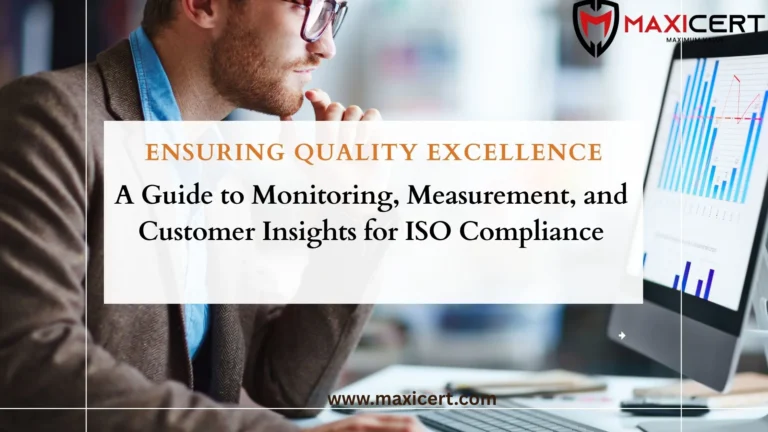Ensuring Quality Excellence: A Guide to Monitoring, Measurement, and Customer Insights for ISO Compliance

Introduction
In today’s competitive business environment, maintaining quality excellence is not just a goal—it’s a necessity. For organizations aiming to achieve and sustain ISO certification, especially ISO 9001 Quality Management System (QMS), effective monitoring, measurement, and customer feedback are critical components. These practices help businesses ensure compliance, drive continual improvement, and enhance customer satisfaction.
Whether you’re a small-scale jam producer, a construction company, or a major player in the oil and gas, automotive, or food manufacturing sectors, understanding how to apply ISO 9001 clauses on performance evaluation is essential for long-term success. At Maxicert, we help organizations implement tailored ISO-compliant monitoring and measurement strategies that align with global standards.
This blog explores how businesses across various industries can effectively use ISO 9001’s requirements on performance evaluation to:
Track key processes and outputs,
Collect meaningful customer insights,
and take corrective actions for improvement.
By leveraging these techniques and expert support from Maxicert, your business can achieve ISO certification success, reduce risks, and deliver exceptional value to your customers.
Request A Free Quote
According to clause 9 of ISO 9001: Performance evaluation
Planning Your monitoring and measuring activities
This clause addresses the wider monitoring, measurement, analysis and improvement of the performance of the quality management stem. You need to plan how you intend to carry out the monitoring and measuring activities that you are going to use.
2-person manufacturer of jams, jellies and associated preserves established monitoring and measurement at the following stages in the system:
- Visual inspection of incoming raw fruit for spoilage, disease, etc.
- Weighing of fruit and recording the mass introduced into the manufacturing process.
- Visual inspection of fruit after peeling, where applicable, for defects which may not have been previously visible.
- Monitoring the condition of the fruit as during heating to ensure that it is not over- or under-cooked (checking the texture, color, aroma and other characteristics of the fruit based on experience and skill)
- Measuring and recording the quantity of sugar and other ingredients added to the batch of fruit being heated
- Visual monitoring of fill levels in jars as an indicator of mass for the specific product being transferred
- Checking the mass of the finished product to ensure that it complies with the legal tolerance for the printed mass of the jar of jam or similar product
- Visual checks on the number of jars packed per case of product
A 6-person Inspection company which, does visual inspection on the structure of Cargo Carrying Units (including wire ropes) for the oil & gas sector has identified the following methods:
- Monitoring of technical competence for inspectors is periodically done by the Team Leader or a subcontracted expert
- Inspectors use a calibrated light meter to measure the level of illumination to determine whether there is adequate ambient illumination is available, or whether additional light is needed to carry out the inspections
- Analysis of the number of inspections carried out by inspectors each month is done to determine whether customer requirements relating to the volume of inspections are being met
- Evaluation of the degree of kink in the wire rope by comparison with a template with a known angle at the vertex
A regulatory inspection agency has determined based on its experience that monitoring of imported electrical items from a new supplier shall be done for the first batch, and for every batch thereafter for the next year. Subsequently monitoring shall be relaxed to once every three months if there are no nonconforming electrical items detected. If nonconformities are detected then monitoring shall be done on a per shipment basis for another calendar year.
A printing company using an offset process has determined based on its experience that measurement of the print dimensions for full-color A3 posters shall be done on one out of every one hundred-(1% inspection) prints.
A shipping agency of 15 employees has monitoring of its quality of service measured by a 1-page survey at the end of every port visit by the captain of the vessel.
A shipping agency of 15 employees has established the following frequencies for analysis and evaluation of customer satisfaction:
- Analysis of customer satisfaction is done by administrative staff when the survey records are returned by the person assigned direct responsibility for the vessel
- Evaluation of the customer satisfaction levels against the company-level quality objective is done on a quarterly basis
A construction company which does excavation, supply and compaction of structural fill material, and provides load-bearing concrete applies the following methods to ensure implementation of monitoring and measurement activities:
- Supervisors are provided with the approved Inspection and Test plans for the job
- The Quality Control person assigned to the job ensures that inspection of stage completion is done prior to the job being allowed to progress to the next stage, e.g., the depth of excavation is verified based on reports from the civil surveyors before approved structural fill is allowed to be placed into the excavated hole
- As the pouring of load-bearing concrete is a process requiring validation (a “special process”), the Quality Control personnel ensure the following records are retained:
- The design mix and actual quantities for the concrete from the batching plant
- Certificates of analysis for the raw materials (cement, water, sand, gravel, etc.) used in preparing the batch of concrete
- Approved procedures for the mixing and delivery (pouring) of concrete
- Competence records for the batch plant operator and the concrete pour operator
- Certification for the batch plant and the concrete pour equipment (e.g., the concrete mixer and pump)
- Records of the characteristics of the concrete at the time of the pour (e.g., a Pour Card) such as slump test result, temperature, water added and quantity of water added.
A supplier of technical services to the oil and gas sector reviews the performance of parts of its QMS on a monthly basis at management meetings. The overall effectiveness of the QMS is evaluated twice a year.
A regulatory agency evaluates quality performance through the use of a “Balanced Scorecard approach on a quarterly basis, and the overall effectiveness of the QMS is evaluated once a year.
According to clause 9.1.2: Customer Satisfaction How satisfied are your customers?
The standard makes it clear that you are to use customer perception as a measure of the performance of your quality management system in meeting customer requirements.
You are required to monitor information on the customers’ perception of how well you satisfied their needs and expectations. that is, your performance as a supplier.
Monitoring of customer satisfaction should be performed on an ongoing basis
The results of your customer satisfaction monitoring should be addressed in your management review and continual improvement activities to identify and implement those changes which will improve the relationship with your customers.
- More than one type of customer
This requirement should not be underestimated. One of the quality principles highlights its importance. You can have more than one type of customer. For example, if you are a manufacturer, you might have wholesalers, retailers, and then the general public. They all have different requirements. For your products to sell successfully. you will need to satisfy them all.
- Satisfaction and dissatisfaction are not opposites!
Understand that satisfaction is not the opposite of dissatisfaction. If customers are dissatisfied, they could react quite badly or strongly, producing a strong negative response. Customers can also have a very strong positive response, ie, one of “delight” (something beyond the normal level of satisfaction).
It is, however, often the case that satisfaction produces a neutral response. Other customers who are dissatisfied may choose not to respond at all. In this case, they simply transfer their business to another supplier Without on-going monitoring, these neutral or less obvious responses are not easily detected by the organization.
- More than one type of customer
This requirement should not be underestimated. One of the quality principles highlights its importance. You can have more than one type of customer. For example, if you are a manufacturer, you might have wholesalers, retailers, and then the general public. They all have different requirements. For your products to sell successfully. you will need to satisfy them all.
- Satisfaction and dissatisfaction are not opposites!
Understand that satisfaction is not the opposite of dissatisfaction. If customers are dissatisfied, they could react quite badly or strongly, producing a strong negative response. Customers can also have a very strong positive response, ie, one of “delight” (something beyond the normal level of satisfaction).
It is, however, often the case that satisfaction produces a neutral response. Other customers who are dissatisfied may choose not to respond at all. In this case, they simply transfer their business to another supplier Without on-going monitoring, these neutral or less obvious responses are not easily detected by the organization.
How many customers should be monitored?
The costs of monitoring all customers might be prohibitive; therefore, you should make a judgement based on criteria such as
- What is the impact of any individual customer on your organization?
- How critical is your product or service to your customer’s organization?
- Are you a volume producer, or a single batch manufacturer or service provider?
- What degree of repeat business will be provided by individual customers?
This will enable you to determine how many, or which customers should be proactively monitored.
Monitoring perception
There are many ways of finding out what your customers think about how well your organization has met their requirements, for example, you may use
- telephone calls made periodically or after delivery of products,
- questionnaires and surveys.
- complaints, monitoring your accounts receivable, warranty claims, etc., suggestions or compliments received from the customer,
- internal enquiries among your personnel who are in contact with customers, and
- analysis of lost business
It is recommended that you start with simple methods such as the monitoring of complaints, suggestions or compliments from your customers, or enquiries among your personnel. Surveys and questionnaires are time consuming and expensive to process. If you do use a questionnaire, then try to keep it simple, choose your questions very carefully and ensure that they are clear, pilot test it before use.
Conclusion
Monitoring, measurement, and customer insights are the backbone of a successful Quality Management System (QMS). By systematically tracking performance, addressing nonconformities, and understanding customer perceptions, businesses can not only achieve ISO 9001 certification but also foster long-term customer loyalty and operational excellence.
Whether you’re inspecting cargo units, printing posters, or pouring concrete, the principles of quality management remain the same: plan, measure, analyze, and improve.
At Maxicert, we support businesses across all industries with expert ISO implementation, internal audits, and compliance strategies. As a top ISO consultant, we help you align with ISO standards, enhance process control, and achieve measurable performance improvements.
Start implementing these strategies today with Maxicert to stay ahead in the race for quality excellence and ISO certification success.

Get In Touch

Get In Touch

Get In Touch
Need A Free Estimate?
Get a free consultation and Checklist to get certified for ISO , HALAL, CE Mark Certification.
FAQ
Why is monitoring and measurement important for ISO certification?
Monitoring and measurement are essential for ensuring that your processes meet ISO standards and customer requirements. They help identify areas for improvement, prevent nonconformities, and provide evidence of compliance during audits.
How can I measure customer satisfaction effectively?
You can measure customer satisfaction through simple methods like monitoring complaints, conducting surveys, or analyzing lost business. Start with low-cost approaches, such as internal feedback from customer-facing staff, and scale up as needed.
What are some common monitoring and measurement activities in different industries?
Examples include visual inspections of raw materials in food manufacturing, technical competence evaluations in inspection companies, and concrete pour records in construction. Each industry tailors its monitoring activities to its specific processes and risks.



